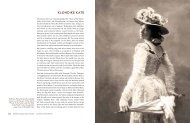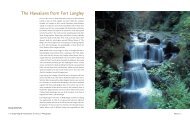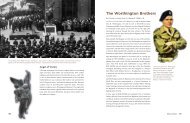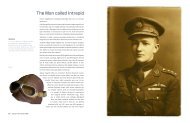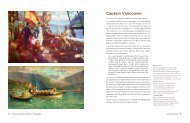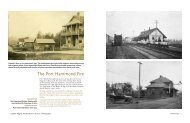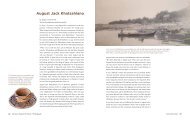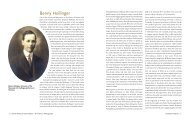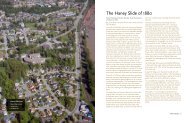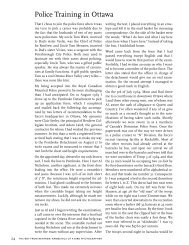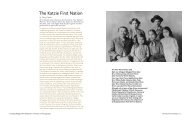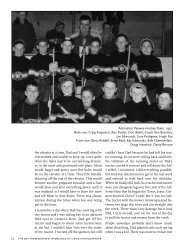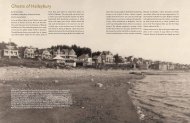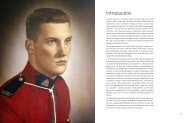Father of Vancouver - Global Bird Photos Collection
Father of Vancouver - Global Bird Photos Collection
Father of Vancouver - Global Bird Photos Collection
You also want an ePaper? Increase the reach of your titles
YUMPU automatically turns print PDFs into web optimized ePapers that Google loves.
<strong>Father</strong> <strong>of</strong> <strong>Vancouver</strong><br />
the centre <strong>of</strong> their business. David ran the Yale location and became<br />
known as a popular host and a staunch protector <strong>of</strong> local interests.<br />
mayors <strong>of</strong> vancouver<br />
1886–1887 Malcolm Alexander MacLean<br />
1888–1891 David Oppenheimer<br />
1892–1893 Frederick Cope<br />
1894 Robert Alexander Anderson<br />
1895–1896 Henry Collins<br />
1897 William Templeton<br />
1898–1900 James Ford Garden<br />
1901 Thomas Owen Townley<br />
1902–1903 Thomas Fletcher Neelands<br />
1904 William J. McGuigan<br />
1905–1906 Frederick Buscombe<br />
1907–1908 Alexander Bethune<br />
1909 Charles Stanford Douglas<br />
1910–1911 Louis Denison Taylor<br />
1912 James Findlay<br />
1913–1914 Truman Smith Baxter<br />
1915 Louis Denison Taylor<br />
1916–1917 Malcom Peter McBeath<br />
1918–1921 Robert Henry Otley Gale<br />
1922–1923 Charles Edward Tisdall<br />
1924 William Reid Owen<br />
1925–1928 Louis Denison Taylor<br />
1929–1930 William Harold Malkin<br />
1931–1934 Louis Denison Taylor<br />
1935–1936 Gerald Gratton McGeer<br />
1937–1938 George Clark Miller<br />
1939–1940 James Lyle Telford, MD, MLA<br />
1941–1946 Jonathan Webster Cornett<br />
1947–1948 Gerald Gratton McGeer<br />
1949–1950 Charles Edwin Thompson<br />
1951–1958 Frederick John Hume<br />
1959–1962 Albert Thomas Alsbury<br />
1963–1966 William George Rathie<br />
1967–1972 Thomas J. Campbell, QC<br />
1973–1976 Art Phillips<br />
1977–1980 John J. Volrich<br />
1981–1986 Michael Franklin Harcourt<br />
1986–1993 Gordon Muir Campbell<br />
1993–2002 Philip Walter Owen<br />
2002–2005 Larry W. Campbell<br />
2005–2008 Sam Sullivan<br />
2008– Gregor Robertson<br />
by Kinley Engdahl-Johnson,<br />
Company Historian, The Oppenheimer Group<br />
Though his name will forever be tied to <strong>Vancouver</strong>, David<br />
Oppenheimer was born half a world away in Blieskastel, Germany.<br />
The fourth son <strong>of</strong> a large Jewish merchant family with ten children,<br />
David was only 14 in 1848 when political turmoil caused the<br />
Oppenheimers to leave Germany for the US. They briefly settled in<br />
New Orleans, where David went to bookkeeping school and worked<br />
in a general store. Soon after, word started filtering across the<br />
country that gold had been discovered in California’s Sierra Nevada<br />
mountains. Ever the opportunists, David and his older brother<br />
Charles set sail for San Francisco via the Isthmus <strong>of</strong> Panama. They<br />
arrived on the West Coast in February <strong>of</strong> 1851 and within a year had<br />
been joined by their youngest brother, Isaac, and were working as<br />
provisions traders in Placer County.<br />
In 1858 the Oppenheimers heard rumours <strong>of</strong> gold being found in<br />
British Columbia’s Fraser Canyon. With the California rush waning,<br />
David and his brothers saw another golden business opportunity<br />
in the making. They sent Charles ahead to Victoria, the jumping<strong>of</strong>f<br />
point for those heading to the interior and the only place to<br />
buy permits and supplies in the region. By 1858 he had opened a<br />
wholesale provisions company and was soon joined by David, Isaac,<br />
and another brother, Godfrey.<br />
The Oppenheimers weren’t content to rest on their laurels, though.<br />
Thousands had come to the Fraser looking for gold, yet returning to<br />
Victoria to stock up on supplies was both dangerous and expensive.<br />
In 1859 David and his brothers opened a second store in Yale, a<br />
natural choice, as it was the highest navigable point on the Fraser<br />
River before it entered the canyon. Their wholesale provisions store,<br />
Oppenheimer Bros., was located on Front Street and became a<br />
popular gathering place for those heading to and from the diggings.<br />
Fortune seekers followed the Fraser north from Yale, eventually<br />
hitting the jackpot in 1861 with a strike in the Williams Creek area.<br />
Barkerville sprang into existence, quickly becoming the biggest<br />
boomtown north <strong>of</strong> San Francisco and west <strong>of</strong> Chicago. In 1862<br />
the brothers set up another location there and in a few years had<br />
warehouses in Hope and Fisherville as well, though Yale remained<br />
The 800-kilometre trip between the Yale and Barkerville stores<br />
was notoriously dangerous, but was also a necessary requirement<br />
for the Oppenheimers’ success. Their pack train was the largest in<br />
the region at the time, with 157 mules. It took the train a month<br />
to travel from one store to the other, as it had to contend with the<br />
elements and grizzlies, and <strong>of</strong>ten had to double-back to evade<br />
robbery attempts along the way. Because <strong>of</strong> the Oppenheimers’<br />
familiarity with the journey, Charles was hired at one point to<br />
help construct a portion <strong>of</strong> the Cariboo Wagon Road connecting<br />
the two towns. Much <strong>of</strong> the Trans-Canada Highway follows the<br />
same route today.<br />
Though business was booming, fire was an ever present and very<br />
real danger on the frontier. The Oppenheimers first discovered just<br />
how real in 1868, when a fast moving fire swept through Barkerville,<br />
levelling the store in minutes. Though they had lost over $100,000<br />
in goods, the disaster was met with immediate action from David,<br />
and he made the first <strong>of</strong> what would be many civic donations.<br />
Determined not to have the tragedy repeat itself when the store was<br />
rebuilt, he headed to San Francisco and purchased a fire wagon that<br />
he then donated to create the first Williams Creek Fire Brigade.<br />
By 1872 business at the Barkerville location had slowed enough that<br />
David and Isaac decided to sell it, focusing their energy again on<br />
Yale. In 1874 their worst fears were realized when the Yale store<br />
burned to the ground. They quickly rebuilt the store with brick.<br />
Around the same time, David protested freight charges on the<br />
Fraser, which he deemed monopolistic. He continued his focus<br />
on improving transport in the region in 1880, and partnered with<br />
Andrew Onderdonk to raise money for the construction <strong>of</strong> several<br />
challenging stretches <strong>of</strong> the Canadian Pacific Railroad.<br />
When fire burned through the wooden ro<strong>of</strong> and gutted the contents<br />
<strong>of</strong> the Oppenheimers’ store in 1881, Yale was no longer the booming<br />
town it had been. David and Isaac headed back to <strong>Vancouver</strong> Island,<br />
where they opened a second Victoria store on Wharf Street in early<br />
1882. However, David’s thoughts were focused on the mainland. He<br />
had watched the approaching completion <strong>of</strong> the CPR closely and had<br />
started to acquire premium plots <strong>of</strong> land in the Granville area as<br />
early as 1878. In 1884 he purchased even more land in what would<br />
become <strong>Vancouver</strong>, and was part <strong>of</strong> the group that convinced the<br />
David Oppenheimer, the city’s second<br />
mayor, eventually came to be affectionately<br />
known as the “<strong>Father</strong> <strong>of</strong> <strong>Vancouver</strong>.”<br />
114 <strong>Vancouver</strong> Exposed: A History in Photographs The Builders 115
CPR to extend the terminus west from Port Moody by<br />
donating 175 acres <strong>of</strong> their own land. Seeing the potential<br />
<strong>of</strong> the area, David and Isaac relocated to <strong>Vancouver</strong> in<br />
1885 and decided to build a permanent brick warehouse.<br />
When the great fire swept through <strong>Vancouver</strong> in 1886,<br />
construction was underway on the new building at the<br />
corner <strong>of</strong> Powell and Columbia Streets, and most <strong>of</strong><br />
the city and the Oppenheimers’ temporary store were<br />
destroyed. Not deterred by yet another setback, the<br />
brothers continued construction, and when the store was<br />
finished in July <strong>of</strong> 1887, it was the first brick building in<br />
<strong>Vancouver</strong>.<br />
In Yale and Barkerville David had shown his propensity<br />
for civic involvement, petitioning for local interests and<br />
playing an active role in both community and regional<br />
development. In the fledgling town <strong>of</strong> <strong>Vancouver</strong>, that<br />
interest blossomed into a passion. David turned his<br />
knowledge <strong>of</strong> business towards helping the city grow.<br />
He served as an alderman on the first city council,<br />
which held meetings in his <strong>of</strong>fice until the construction<br />
<strong>of</strong> the new city hall — which was being built on land<br />
he donated — was finished. He gained popularity in<br />
the community for his work as chairman <strong>of</strong> the city’s<br />
finance committee. In November <strong>of</strong> 1887 he was named<br />
the first president <strong>of</strong> the <strong>Vancouver</strong> Board <strong>of</strong> Trade, and<br />
just a month later was elected as the city’s second mayor.<br />
David had a particular vision for the city he believed<br />
<strong>Vancouver</strong> could be and was determined to make<br />
his vision a reality. From 1888 to 1891 he served<br />
four consecutive terms as mayor, with no pay for his<br />
duties. He was passionate about making the city the<br />
international port <strong>of</strong> call he felt was vital to the success<br />
<strong>of</strong> the province — and the Dominion <strong>of</strong> Canada. As the<br />
first president <strong>of</strong> the <strong>Vancouver</strong> Board <strong>of</strong> Trade, he wrote<br />
about fostering trade with Japan, Australia and New<br />
Zealand, and <strong>of</strong> the fundamental need to both import<br />
and export goods. He worked with the CPR to establish<br />
direct shipping routes between <strong>Vancouver</strong>, Japan and<br />
Australia. He founded the British Columbia Fruit<br />
Growers Association in 1888 with the hope <strong>of</strong> supporting<br />
the growers <strong>of</strong> the region so that BC-grown fruit would<br />
be exported to all reaches <strong>of</strong> the world, and the exotic<br />
fruits <strong>of</strong> the world imported in turn.<br />
As mayor he was responsible for creating the city<br />
water works and lighting company, as well as the fire<br />
department, paved streets, sidewalks, and the sewage<br />
system. He initiated the city’s first transportation<br />
system by creating the <strong>Vancouver</strong> Electric Railway and<br />
Light Company, and the Westminster and <strong>Vancouver</strong><br />
Tramway. The first Cambie Street Bridge and the first<br />
Granville Bridge were opened while he was in <strong>of</strong>fice. He<br />
opened Stanley Park in 1888 and established the Parks<br />
Board.<br />
David <strong>of</strong>ten invested his own money and much <strong>of</strong> his<br />
personal time on projects that benefited the community,<br />
such as the construction <strong>of</strong> a public wharf. He served as<br />
mayor without pay and donated his own land for schools<br />
and parks. He was involved in the creation <strong>of</strong> the city’s<br />
YMCA, the Alexandra Orphanage, the British Columbia<br />
Exhibition Association, and the <strong>Vancouver</strong> Club.<br />
Though English was his second language, David was<br />
a prolific and competent communicator, and he wrote<br />
extensively on his vision for <strong>Vancouver</strong>. To attract settlers<br />
to the city, he authored several pamphlets outlining the<br />
potential <strong>of</strong> the region for distribution in London and<br />
the United States. He has <strong>of</strong>ten been called the “<strong>Father</strong><br />
<strong>of</strong> <strong>Vancouver</strong>” for his contributions. On his retirement<br />
from the position <strong>of</strong> mayor in early 1892 due to his<br />
failing health, the Daily Colonist ran the following:<br />
Mr. Oppenheimer has been for four years<br />
Mayor <strong>of</strong> <strong>Vancouver</strong>, and he has served his<br />
fellow citizens faithfully and efficiently.... He has<br />
watched over [<strong>Vancouver</strong>'s] infancy — has, as it<br />
were, superintended the laying <strong>of</strong> its foundation.<br />
He has fostered its growth, which has been<br />
unprecedentedly rapid, and has very materially<br />
aided its wonderful development. Such supervision<br />
as he has exercised required, in order to do it well,<br />
all the best qualities <strong>of</strong> an able man <strong>of</strong> business, and<br />
Mr. Oppenheimer has done it well. It is fortunate<br />
for <strong>Vancouver</strong> that it was able to avail itself <strong>of</strong> the<br />
services <strong>of</strong> such a man as David Oppenheimer at<br />
the most critical stage <strong>of</strong> its existence. It will take<br />
time for even its citizens fully to appreciate all that<br />
he has done for them and their city.<br />
David Oppenheimer was twice married. He married his<br />
first wife Sarah in 1857. She died at age 40 in 1880. This<br />
marriage produced no children. David married is second<br />
wife, Julia Walter <strong>of</strong> New York, in San Francisco in 1883.<br />
They had a daughter Flora. Julia died in a tragic accident<br />
in March 1897, and David, who had been sick <strong>of</strong>f and on<br />
for years, died 9 months later on 31 December 1897.<br />
To best get a sense <strong>of</strong> David Oppenheimer’s dedication to<br />
the city and province, one need look no further than the<br />
following excerpt from the <strong>Vancouver</strong> Daily World that<br />
was published shortly after his death:<br />
He was not all things to all men, he was the same<br />
thing to all men; genial, honest, and kind-hearted<br />
to a fault. The voice <strong>of</strong> sorrow never failed to win<br />
his keenest sympathy, and the voice <strong>of</strong> suffering<br />
had not to call twice to him for help. Yet with all his<br />
large-heartedness, he was practical to a degree and<br />
could grasp a business proposition as clearly as any<br />
man living. That he took an almost fatherly pride<br />
in <strong>Vancouver</strong> has been exemplified time and again.<br />
He saw into the future further than the ordinary<br />
eye could reach, and planned and built accordingly.<br />
Even as he lay on his deathbed and felt that the end<br />
could not be very far away, he said he had no fear<br />
<strong>of</strong> death but that he would like … to see <strong>Vancouver</strong><br />
enjoy the prosperity that he had always said would<br />
be hers and which he felt was now at hand.<br />
Another article called David the best friend that<br />
<strong>Vancouver</strong> ever had, but the same could be said as vice<br />
versa — that <strong>Vancouver</strong>, in some ways, was his closest<br />
and dearest friend, who he saw great things for in the<br />
future. The company David and his brothers founded<br />
in 1858 is still in business. Today it is called The<br />
Oppenheimer Group, a marketer <strong>of</strong> over 100 varieties <strong>of</strong><br />
fresh produce grown in 26 countries to retail, wholesale<br />
and foodservice customers across North America.<br />
It has grown into a half-billion-dollar company with<br />
<strong>of</strong>fices throughout the US, Canada and Chile, selling<br />
40 million boxes <strong>of</strong> produce annually — four billion<br />
individual pieces <strong>of</strong> fruit. Though it has grown into an<br />
international powerhouse with grower partners around<br />
the world, Oppenheimer’s roots are still and always<br />
will be firmly planted in British Columbia. It has been<br />
named the oldest continually operating business in the<br />
province by the <strong>Vancouver</strong> Historical Society, and it<br />
celebrated its 150 th anniversary in 2008. The 12 th <strong>of</strong> July<br />
was named “David Oppenheimer Day” in the City <strong>of</strong><br />
<strong>Vancouver</strong>. A ceremony was held to celebrate the event<br />
in Stanley Park near David’s memorial statue. Members<br />
<strong>of</strong> the Oppenheimer family, as well as delegates from<br />
the city, the Parks Board, and staff <strong>of</strong> the Oppenheimer<br />
Group attended the ceremony.<br />
Though memories fade over time, it is easy to see the<br />
legacy <strong>of</strong> David Oppenheimer today. One just has to<br />
look around oneself, at the city he loved so much, which<br />
continues to thrive more than a century after his death.<br />
To commemorate his contributions to the city,<br />
a memorial statue <strong>of</strong> David Oppenheimer was<br />
placed at the entrance to Stanley Park in 1911.<br />
116 <strong>Vancouver</strong> Exposed: A History in Photographs The Builders 117



